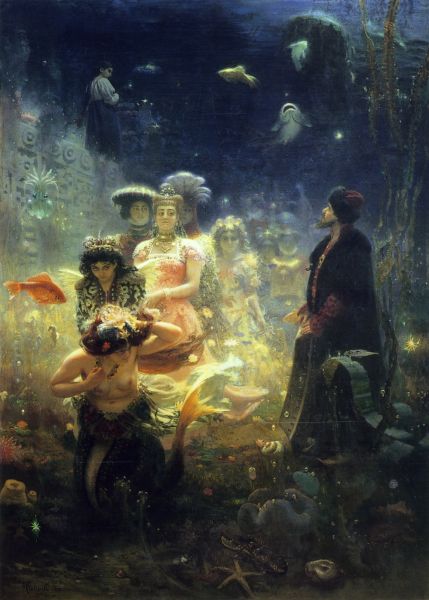|
|
Sadko. 1876

Repin Ilya,
Oil on сanvas
322,5 x 230
State Russian Museum
Annotation
The painting was commissioned by the future Tsar Alexander III. Based on the subject of a Novgorod epic poem (bylina), it depicts the merchant Sadko in the underwater kingdom. Repin painted the work when he was a fellow of the Imperial Academy of Arts in France. Cut off from his usual environment, the young artist employed the folklore theme to express his mood and state of mind. The picture depicts various beauties, each personifying a different nation or people. Although entranced by every one of them, Sadko nevertheless chooses the Russian girl, Chernava, to be his bride. As the artist wrote at the time: “The idea expresses my true state and perhaps the state of our as-of-yet still Russian art.” In his search for artistic devices adequately expressing the conceived image, Repin was aided by impressions of the magnificent pageantry of the European salons. Always aspiring to achieve maximum authenticity, the artist studied maps of the sea world, sketched the sea-life of Normandy and toured Crystal Palace in London. In 1876, he was made an academician for this monumental canvas.
Author's Biography
Repin Ilya
Repin, Ilya Yefimovich
1844, Chuguyev (Kharkiv Province) - 1930, Kuokkala (Finland)
Painter, draughtsman, watercolour painter, portraitist, history painter. Studied under local artists at the School of Military Topography in Chuguyev (1854-57), under Ivan Kramskoi at the School of Drawing, Society for the Encouragement of Artists (1863) and at the Imperial Academy of Arts (1864-71). Fellow of the Imperial Academy of Arts in Italy and France, lived mostly in Paris (1873-76). Academician (1876). Professor, full member of the Imperial Academy of Arts (1893). Member of the Society of Travelling Art Exhibitions (1878, exhibited from 1874). Headed a studio at the Higher School of Art, Imperial Academy of Arts (1894-1907) and taught at Princess Maria Tenisheva''s school of art (1895-98). Lived in St Petersburg and Moscow, settled in Kuokkala (1900).

